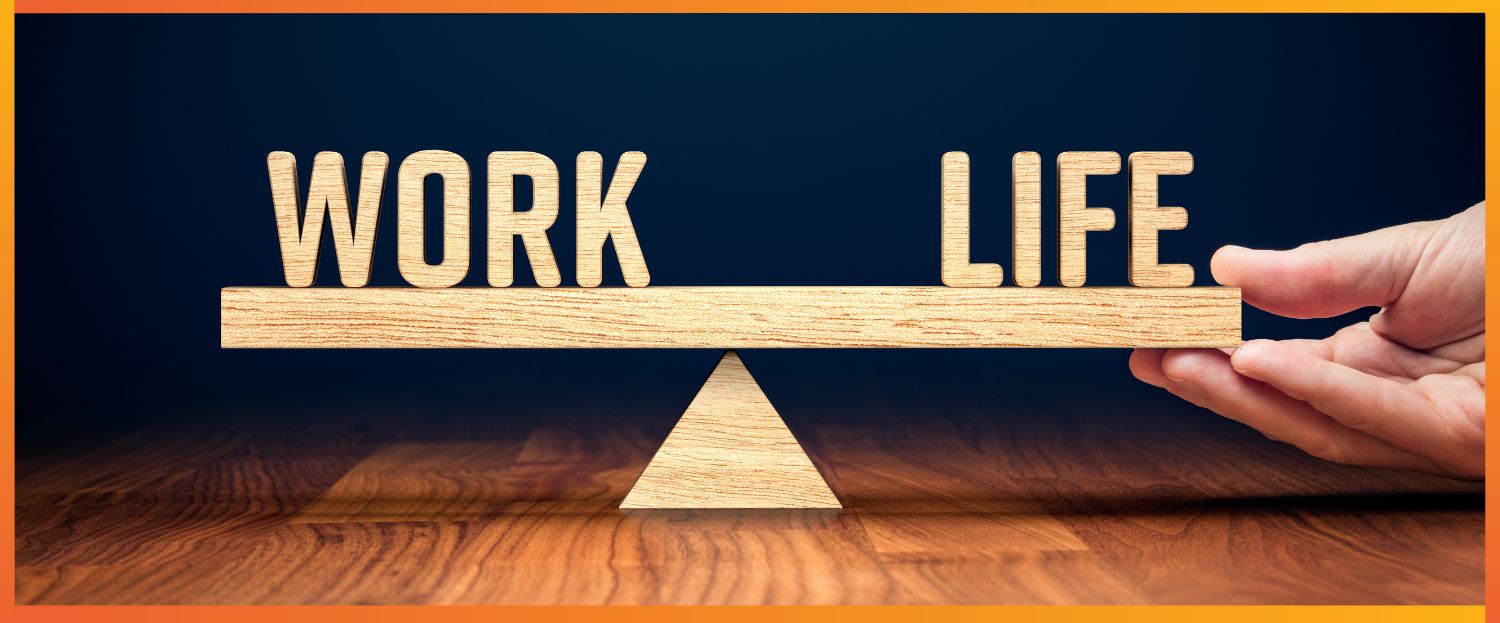The Importance of Work-Life Balance: Strategies for Achieving Harmony
Work-life balance is a critical aspect of your overall well-being. It's the equilibrium that allows you to effectively manage your time and energy between your work responsibilities and personal life.
Achieving a satisfactory work-life balance can lead to improved mental health, as it often results in lower stress levels and a better emotional state.
By setting boundaries and prioritising your health and personal activities, you build a more sustainable lifestyle that can support both career success and personal contentment.
In today's fast-paced environment, you may find yourself juggling multiple tasks, both professional and personal, which can be overwhelming and lead to burnout.
The integration of work-life balance strategies into your daily routine is essential in maintaining your mental health and preventing the negative consequences that can arise from chronic stress.
Remember, your mental health is just as important as your physical health, and they are often interconnected.
By valuing and striving for work-life balance, you're not only investing in your current well-being but also setting the foundation for a more fulfilling future.
It allows you to nurture relationships, explore personal interests, and take time for self-care, which collectively contribute to a more rounded life experience.
Whether you're employed full-time, part-time, or are self-employed, finding the right balance is key to a healthier, happier you.
Understanding Work-Life Balance
Work-life balance is essential for maintaining a healthy lifestyle, ensuring your professional responsibilities are in harmony with your personal life. For further inspiration and guidance on achieving this balance, explore our article 54 Powerful Quotes to Help You Find Your Work-Life Balance where wisdom and insights await to aid you on your journey.

Defining Work-Life Balance
Work-life balance refers to the equilibrium where you sufficiently meet your professional responsibilities while having ample time and energy for your personal life.
This balance hinges on aligning your work duties with your personal values, goals, and priorities to facilitate a fulfilling life both in and outside of work.
History and Evolution of Work-Life Balance
The concept of work-life balance has evolved from the industrial age's sharp division of work and home life to a modern understanding that these areas are interconnected.
With technological advances, the rigid boundaries have blurred, giving rise to work-life integration—a more fluid approach enabling work and personal tasks to intermingle throughout the day.
The Role of Work-Life Integration
Work-life integration acknowledges that work and personal duties aren't always separate and promotes a flexible approach to manage them.
It's a realistic view, particularly in a world where remote and digital work have become common.
Your aim with integration is to achieve your goals and satisfy your priorities without the stress that comes from a strict separation of work and personal life.
Assessing Personal Work-Life Balance
Taking stock of your work-life balance involves a personal assessment where you gauge:
- Professional responsibilities: Are they aligning with your personal values and allowing you to meet your goals?
- Personal life: Do you have the time and resources to enjoy your life outside of work and fulfil your priorities?
Use the list below to help you assess your current work-life balance:
- Professional Fulfilment:
- Satisfaction with your work achievements
- Alignment with your career objectives
- Opportunities for professional development that help you grow your skills and advance in your career
- Your workplace environment and culture promote a healthy, supportive, and inclusive atmosphere
- You feel appreciated and recognised for your contributions and hard work through adequate recognition and rewards
- Personal Satisfaction:
- Quality time spent on hobbies and with loved ones
- You maintain a healthy lifestyle with regular exercise and proper nutrition, contributing to your physical health and wellness
- You feel emotionally supported and are able to manage stress effectively, ensuring your emotional well-being
- You find opportunities to learn new things, pursue interests, and grow personally outside of work, fostering personal growth and learning
Benefits of Work-Life Balance
Achieving a work-life balance is essential for your well-being and job performance. This balance positively impacts your mental and physical health, strengthens relationships, and enhances your job satisfaction and productivity.

Improvements in Mental Health
Balancing your professional and personal life leads to significant reductions in stress and anxiety, which are common detriments to mental health.
By allocating time for rest and recreation, you are less likely to experience the symptoms of depression. A study shows:
- Stress Levels: Recent studies indicate that increased autonomy in our work leads to reduced stress levels.
- Anxiety Rates: Results of a Government funded 4 day week study found that anxiety fell by 21%.
Physical Health Advantages
Your physical health can see measurable benefits from a well-managed work-life boundary. It can translate to:
- Better Sleep: More time to wind down leads to improved sleep quality and duration.
- Increased Activity: With extra time, you’re more likely to engage in physical exercise, which boosts overall health.
Consistent physical activity and restorative sleep are fundamental for maintaining your health, reducing the risk of chronic diseases, and enhancing immune function.
Enhancement of Relationships
When you dedicate time to your personal life, relationships with family and friends flourish. You create space for valuable interactions, which in turn:
- Improve Support Networks: Strengthened personal relationships ensure a better support system during stressful times.
- Enrich Emotional Connections: Regularly spending quality time with loved ones enhances emotional bonds and shared experiences.
These strong relationships play a critical role in your emotional health and resilience.
Job Satisfaction and Productivity
A balance between work and life has a cyclical effect on your productivity and job contentment:
- Increased Engagement: With adequate rest, you return to work more focused and engaged.
- Higher Productivity: Refreshed individuals often demonstrate a 20% surge in productivity.
- Job Satisfaction: Satisfying personal life experiences translate to a more positive outlook towards your job.
Challenges to Work-Life Balance
In today's fast-paced environment, maintaining work-life balance is crucial yet challenging, largely due to extended working hours, the complexities of remote work, cultural expectations, and personal obligations all demanding your attention and energy.

The Impact of Long Hours
Your commitment to long hours at work can significantly hinder your ability to balance personal and professional life.
Regularly extending your workday may lead to increased stress and a reduction in time available for rest and relaxation.
Organisations often demand extended availability, especially in competitive industries, which may result in chronic fatigue and decreased productivity.
Remote Work and Boundary Blur
Remote work, although offering flexibility, can often lead to a blurring of boundaries between your job and your home life.
With the office just a few steps away, you might find it difficult to log off and transition to personal time.
The absence of a physical commute can make it tough to delineate clear start and end times for your workday, resulting in longer hours and heightened stress levels.
Cultural and Societal Pressures
You may face societal pressures to consistently prioritise work over personal life, especially in cultures that equate long working hours with success and dedication.
This cultural expectation can create an environment where you feel compelled to sacrifice personal time for career advancement.
Personal Responsibilities and Career Demands
Juggling personal responsibilities, such as family commitments, along with the demands of your job, can be a delicate balancing act.
Family responsibilities require time and attention, but when your career also demands a significant portion of your energy, the scale can tip, causing stress and potential strain on family dynamics.
In managing these challenges, it's important to set clear boundaries, communicate effectively with employers and family, and recognise the importance of taking time for oneself.
Strategies for Achieving Work-Life Balance
Adopting effective strategies for work-life balance is crucial for maintaining productivity and well-being. Situating boundaries, managing time, prioritising self-care, and utilising workplace flexibility can profoundly impact your quality of life.

Setting Clear Boundaries
Establishing boundaries means defining when your workday starts and ends. You can create a routine that separates professional and personal time. For example:
- Work Hours: Set your work hours and communicate them clearly to colleagues and clients.
- Physical Space: Designate a specific area for work, especially if working from home, to reinforce a psychological boundary.
- Digital Detox: Implement regular periods where you disconnect from work-related emails and messages outside of your set work hours. This helps to prevent work from spilling into your personal time and reduces stress.
- Personal Commitments: Schedule personal activities and commitments into your calendar just as you would with work meetings. This ensures that your personal time is protected and valued, encouraging a healthier balance between work and life.
Time Management and Prioritisation
Effective time management enables you to meet career obligations while leaving space for personal interests and hobbies. Prioritise tasks by urgency and importance using the following methods:
- To-Do Lists: Start each day with a list ordered by priority.
- Calendar Blocking: Schedule blocks of time for specific tasks or projects to avoid overcommitting.
- Delegation: Identify tasks that can be delegated to others. This not only lightens your workload but also helps in focusing on tasks that require your specific expertise or attention.
- The 80/20 Rule: Apply the Pareto Principle by focusing on the 20% of tasks that will yield 80% of the results. This helps in identifying and prioritising tasks that have the greatest impact on your goals and productivity.
The Importance of Self-Care
Self-care is non-negotiable for a balanced life. Integrating it into your routine bolsters your ability to handle work stress.
- Activities: Engage in hobbies and interests that rejuvenate you.
- Breaks: Take regular short breaks throughout the day to refresh your mind.
- Mindfulness and Meditation: Practise mindfulness or meditation to reduce stress, enhance focus, and improve emotional well-being. Even a few minutes a day can make a significant difference in managing work-life balance.
- Nutritional Well-being: Focus on maintaining a balanced diet that fuels your body and mind. Eating nutritious meals can enhance your energy levels, improve concentration, and support overall health, contributing positively to your work-life balance.
Leveraging Flexibility in the Workplace
Flexibility in working arrangements can help you balance demands more effectively. If available, consider:
- Flexible Hours: Opt for start and end times that align with your peak productivity periods.
- Remote Work: Utilise the option to work from home when necessary to manage personal responsibilities without compromising work quality.
- Compressed Workweek: Explore the possibility of a compressed workweek, where you work longer hours on fewer days. This arrangement can free up entire days for personal time, enhancing work-life balance.
Work-Life Balance in Different Contexts
Work-life balance varies greatly depending on cultural, occupational, and personal circumstances. Your ability to balance professional duties with personal life can be influenced by these different factors.

Comparing Work-Life Balance Around the World
Work-life balance varies significantly around the globe, influenced by cultural norms and labour laws. In the United States, the average workweek is about 34.4 hours, yet employees face the unique challenge of having no statutory paid leave, which contrasts sharply with other countries. For example, the United Kingdom offers a more balanced approach, with workers averaging 37.1 hours per week alongside a generous entitlement of 28 days paid holiday, emphasising a clear separation between work and leisure.
In contrast, countries like France and Spain champion even more worker-friendly policies, mandating 35 and 36.4 average weekly hours respectively, coupled with around 30 days of paid holiday, fostering environments that heavily prioritize work-life balance. Similarly, Germany’s work culture reflects a commitment to balancing professional and personal life, with an average workweek of 34.3 hours and a holiday entitlement that ranges from 20 to 30 days, depending on the region and sector.
Canada presents a varied picture, with average work hours at 36.6 per week and paid holiday entitlement that varies by province, generally ranging between 10 to 20 days, including public holidays. This diversity in work-life balance practices underscores the importance of local labour laws and cultural values in shaping the daily lives of workers across different nations.
|
Country |
Avg. Work Hours/Week |
Paid Holiday Entitlement |
|
US |
34.4 |
0 days (no statutory entitlement) |
|
UK |
37.1 |
28 days (including public holidays) |
|
France |
35 |
30 days (including public holidays) |
|
Canada |
36.6 |
Varies by province, generally 10-20 days including public holidays |
|
Spain |
36.4 |
30 days (including public holidays) |
|
Germany |
34.3 |
20-30 days (depending on the state and the working days per week) |
Diverse Professional Roles and Work-Life Balance
Different jobs offer varying challenges for work-life balance. For instance, nurses and teachers face distinct work-life balance pressures.
Nurses often work irregular hours and long shifts, which can strain family life. Teachers may have better hours during the term but face responsibilities like marking and planning that cut into their free time.
- Nurses: Shift work; irregular hours.
- Teachers: Term-time hours; out-of-hours responsibilities.
- IT Professionals: On-call responsibilities and tight project deadlines.
- Entrepreneurs: Unpredictable work hours with a need for constant connectivity.
Student Life and Work Balance
As a university student, balancing studies with part-time work or family responsibilities can be challenging.
The pressure to excel academically while managing a job can be considerable, but it's important for your wellbeing to find equilibrium.
|
Aspect |
Consideration for Balance |
|
Studies |
Course workload, deadlines |
|
Part-time Work |
Shift patterns, work hours |
The Effect of Parenthood on Work-Life Balance
Parenthood introduces significant changes to your work-life dynamic. Parents must navigate their careers alongside childcare.
Flexible working arrangements, such as working from home or part-time hours, can be key in managing your dual roles effectively.
|
Role |
Balance Factor |
|
Working Parents |
Childcare, flexible hours |
|
Family Commitments |
Holidays, shared responsibilities |
Your work-life balance is influenced by many variables. Recognising the context in which you operate allows you to strategize for better equilibrium between your professional and personal life.
Impact of Technology and Modern Trends
In this section, you'll discover how technology influences your ability to maintain work-life balance, as well as the shifts in workplace trends and their implications.

The Influence of Digital Connectivity
You live in a world where digital connectivity is omnipresent, allowing you to engage with work anytime and anywhere. This constant connection can lead to difficulties in fully disconnecting from work duties.
For instance, smartphones enable real-time email and work notifications. If not managed properly, these can encroach on personal time and impede your ability to truly unwind.
Telecommuting and Virtual Workspaces
The advent of telecommuting has redefined the traditional work environment. Remote work became a necessity during the coronavirus pandemic, accelerating a shift towards virtual workspaces.
With remote work, your daily commute is eliminated, presenting opportunities for a more flexible work schedule. However, this flexibility requires discipline to establish boundaries between professional and private life, ensuring neither is neglected.
- Benefits:
- Increased productivity from a comfortable environment
- Customised and potentially healthier work routines
- Challenges:
- Potential isolation
- Overworking due to lack of clear work-time limits
Emerging Trends Post-Pandemic
Post-pandemic, workplace trends continue to evolve. You've observed a broader acceptance of remote work, with many companies adopting hybrid models that blend office and home working.
The goal is to balance the need for in-person collaboration with the flexibility afforded by remote work options, aiming to promote both team cohesion and individual well-being.
- Notable Changes:
- Adoption of hybrid work models
- Use of collaborative technologies
- Focus on employee mental health
Workplace Innovations and Work-Life Balance
To adapt to modern demands, workplaces are innovating with new technologies and policies that emphasise work-life balance. Tools that streamline workflows and automate mundane tasks are becoming commonplace.
It's crucial to consider how these innovations affect your workday: they must enhance efficiency without leading to an always-on mentality.
- Innovation Examples:
- Project management software
- Communication platforms that simulate an office environment
- Mindfulness and well-being apps integrated into the work process
Measuring and Maintaining Work-Life Balance
Effective work-life balance is vital for your well-being and satisfaction. This section provides you with concrete methods to assess and sustain a healthy equilibrium between your personal and professional life.

Tools for Evaluating Work-Life Balance
To gauge your work-life balance, utilise tools like time-tracking apps and wellness journals.
Time-tracking apps enable you to pause and pay attention to how your hours are distributed across various activities. Meanwhile, jotting down your emotions and energy levels in a wellness journal can help you reflect on your personal well-being.
Continuous Personal Development and WLB
Enrich your professional life without overshadowing personal time by pursuing relevant professional certificates in a structured manner.
Allocate time weekly for learning, which allows for continuous personal development while maintaining a balance.
Incorporating Regular Reviews and Adjustments
On a monthly basis, review your commitments and refine your schedule to address imbalances.
Making regular adjustments ensures that your work engagements do not consistently encroach upon your personal time, preserving your overall well-being.
Encouraging Workplace Support for Work-Life Balance
Advocate for policies in your workplace that bolster work-life balance. These can include flexible working hours and mental health days.
A supportive work environment will encourage employees to repeat beneficial habits, promoting both satisfaction and productivity.
Real-Life Implications of Work-Life Balance
The balance between your professional and personal life can significantly impact both your well-being and career progression. By examining real cases, you can better understand the tangible effects and develop strategies to maintain this crucial balance.
Hypotheticals Highlighting Work-Life Balance
- Example 1: Flexible Work Hours
- Challenge: John, a software developer, faced difficulty in juggling project deadlines and parental responsibilities.
- Solution: His company adopted a flexible working hours policy.
- Result: John reported higher job satisfaction and improved family relationships.
- Example 2: Mandatory Overtime
- Challenge: Emma, a nurse, experienced burnout due to continuous mandatory overtime.
- Solution: The hospital reviewed its staffing needs.
- Result: Reduced mandatory overtime led to lower staff turnover.
Success Stories and Cautionary Tales
- Success Story: Sarah, an entrepreneur, ensured regular breaks and hobbies outside work. Her friendships flourished, and she maintained a low stress level, avoiding high blood pressure.
- Cautionary Tale: Michael, a financial analyst, ignored signs of stress. His work consumed his personal time, leading to strained relationships with loved ones and eventually a stroke.
The Consequences of Poor Work-Life Balance
- Health Risks
- Burnout: High levels of prolonged stress.
- Physical Health: Increased risk of high blood pressure and strokes.
- Personal Life Disruptions
- Friendships: Less time to nurture relationships.
- Loved Ones: Compromises on quality time can strain relationships.
- Professional Setbacks
- Job Performance: Stress can decrease productivity.
- Career Challenges: Poor balance may limit long-term career growth.




